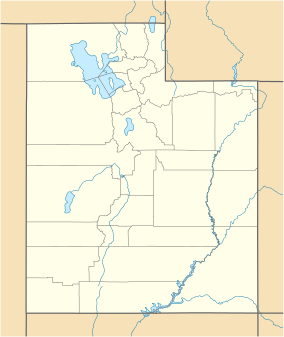| Utahraptor State Park | |
|---|---|
| Location | Grand County, Utah United States |
| Nearest town | Moab, Utah |
| Coordinates | 38°42′47″N 109°42′04″W / 38.71306°N 109.70111°W |
| Area | 6,500 acres (26 km2) |
| Established | March 16, 2021 |
| Named for | Utahraptor |
| Operator | Utah Division of State Parks & Recreation |
| Website | stateparks |
Utahraptor State Park is a state park in Grand County, Utah, United States, about 14 miles (23 km) northwest of Moab.[1]
Description[edit]
The park is located east of U.S. Route 191 and west of Arches National Park, and covers 6,500 acres (26 km2). The park contains the Dalton Wells Quarry, which have yielded remains of dinosaurs that have advanced understanding of paleontology, such as those of the giant dromaeosaur dinosaur Utahraptor ostrommaysi.[2] Fossils found in the park include those from the early Cretaceous at least 135 to 110 million years ago, such as dinosaurs, such bird-like Nedcolbertia, armoured Gastonia, and long-necked Moabosaurus.[3]
History[edit]
Dalton Wells is also the site of a historic Civilian Conservation Corps camp that was later used as the Moab Isolation Center, an internment camp for Japanese Americans during World War II.[1][4][5]
In 1975, palaeontologist Jim Jensen from Brigham Young University dug at the site. In 1993, Jim Kirkland, Robert Gaston, and Donald Burge used fossils from Dalton Wells and elsewhere to describe a new giant raptor, naming it Utahraptor.[6]
In 2001, a large block was excavated, containing several specimens of Utahraptor, representing a large group surrounding an ornithopod dinosaur. In 2013, further research of it began, currently ongoing,[7][8] overseen by Kirkland.
On March 11, 2021 state legislators passed a bill to create Utahraptor State Park.[9] The law that established the park was sponsored by state representative Steve Eliason. The legislation which created the park also included the establishment of the Lost Creek State Park in Morgan County.[4]
See also[edit]
References[edit]
- ^ a b McKellar, Katie (February 18, 2020). "Utahraptor State Park would protect discovery site of Utah's namesake dinosaur: Lawmaker seeks $10 million to establish Utah's 45th state park, conserve world-famous fossil treasure trove". Deseret News. Salt Lake City: Deseret Digital Media. Retrieved September 19, 2021.
- ^ Currie, Philip J.; Padian, Kevin (October 6, 1997). Encyclopedia of Dinosaurs. Elsevier Science. p. 165. ISBN 9780080494746. Retrieved April 19, 2021.
- ^ Gehrke, Robert (April 18, 2021). "Robert Gehrke: Utah is home to the richest deposits of dinosaurs on the planet, and now they will be protected". The Salt Lake Tribune. Salt Lake City: The Salt Lake Tribune, Inc. Retrieved April 19, 2021.
- ^ a b Rodgers, Bethany (March 17, 2021). "Gov. Spencer Cox signs bill to create Utahraptor State Park near Moab: The governor also signed measures on COVID-19 vaccines and launching a state flag review". The Salt Lake Tribune. Salt Lake City: The Salt Lake Tribune, Inc. Retrieved September 19, 2021.
- ^ Burton, Jeffery F.; Farrell, Mary M.; Lord, Florence B.; Lord, Richard W. (July 2011). Confinement and Ethnicity: An Overview of World War II Japanese American Relocation Sites. Seattle: University of Washington Press. pp. 326–327. ISBN 9780295801513. Retrieved April 19, 2021.
- ^ Black, Riley (February 22, 2011). "What Do We Really Know About Utahraptor?". Smithsonian Magazine. Retrieved April 19, 2021.
- ^ Stilson, Ashley (September 4, 2017). "Utahraptor Project aims to draw real picture of ancient creature". Deseret News. Retrieved April 19, 2021.
- ^ "Utah Considers State Park Named For Utahraptor Dinosaur". NPR.org. Retrieved March 4, 2021.
- ^ "Robert Gehrke: Utah is home to the richest deposits of dinosaurs on the planet, and now they will be protected". The Salt Lake Tribune. Retrieved April 20, 2021.
External links[edit]
- Official website
- H.B. 257 Utah State Park Amendments (law establishing the park, 2021)
- H.B. 322 Utahraptor State Park (previous bill, 2020)
- Noehill: Dalton Wells Civilian Conservation Corps Camp and Moab Relocation Center

